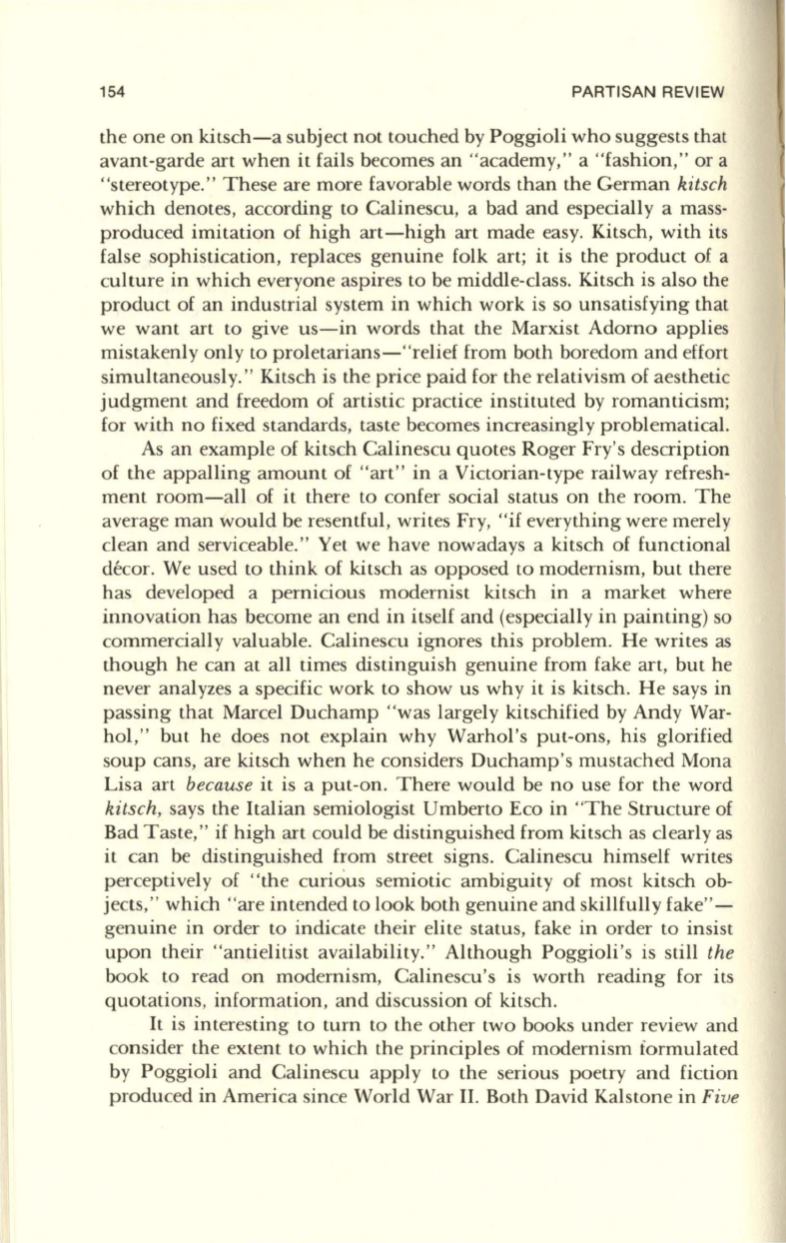
154
PARTISAN REVIEW
the one on kitsch-a subject not touched by Poggioli who suggests that
avant-garde art when it fails becomes an " academy," a " fashion ," or a
"stereotype. " These are more favorable words than the German
kitsch
which denotes, according to Calinescu, a bad and especially a mass–
produced imitation of high art-high art made easy. Kitsch, with its
false sophistication, replaces genuine folk art; it is the product of a
culture in which everyone aspires to be middle-class. Kitsch is also the
product of an industrial system in which work is so unsatisfying that
we want art to give us-in words that the Marxist Adorno applies
mistakenly only to proletarians-" relief from both boredom and effort
simultaneously. " Kitsch is the price paid for the relativism of aesthetic
judgment and freedom of artistic practice instituted by romanticism;
for with no fixed standards, taste becomes increasingly problematical.
As an example of kitsch Calinescu quotes Roger Fry's description
of the appalling amount of "art" in a Victorian-type railway refresh–
ment room-all of it there to confer social status on the room. The
average man would be resentful , writes Fry, " if everything were merely
clean and serviceable. " Yet we have nowadays a kitsch of functional
decor. We used to think of kitsch as opposed to modernism, but there
has developed a pernicious modernist kitsch in a market where
innovation has become an end in itself and (especially in painting) so
commercially valuable. Calinescu ignores this problem. He writes as
though he can at all times distinguish genuine from fake art, but he
never analyzes a specific work to show us why it is kitsch. He says in
passing that Marcel Duchamp "was largely kitschified by Andy War–
hol," but he does not explain why Warhol's put-ons, his glorified
soup cans, are kitsch when he considers Duchamp's mustached Mona
Lisa art
because
it is a put-on. There would be no use for the word
kitsch,
says the Italian semiologist Umberto Eco in "The Structure of
Bad Taste, " if high art could be distinguished from kitsch as clearly as
it can be distinguished from street signs. Calinescu himself writes
perceptively of " the curious semiotic ambiguity of most kitsch ob–
jects," which "are intended to look both genuine and skillfully fake" –
genuine in order to indicate their elite status, fake in order to insist
upon their "antielitist availability. " Although Poggioli's is still
the
book to read on modernism, Calinescu's is worth reading for its
quotations, information, and discussion of kitsch.
It is interesting to turn to the other two books under review and
consider the extent to which the principles of modernism formulated
by Poggioli and Calinescu apply to the serious poetry and fiction
produced in America since World War II. Both David Kalstone in
Five


